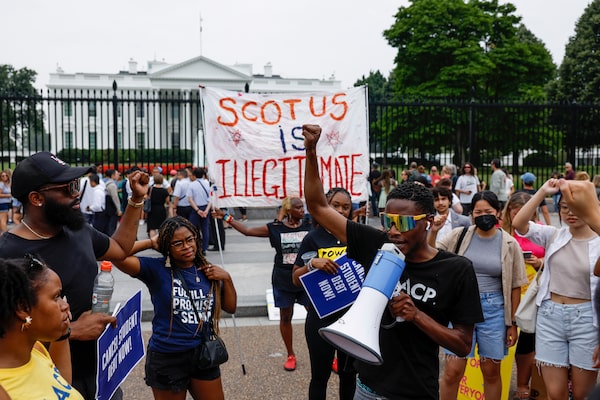
Derrick Lewis with the NAACP leads student debt relief activists in a chant in front of the White House after the U.S. Supreme Court struck down President Biden's student debt relief program on June 30 in Washington, D.C.Anna Moneymaker/Getty Images
The U.S. Supreme Court has blocked President Joe Biden’s student debt relief program and allowed some businesses to discriminate against LGBTQ people in rulings that cement the rightward turn of the country’s highest tribunal.
Friday’s decisions were announced a day after the court struck down race-conscious university admissions programs and a year after it ended federal abortion protections. These rulings all strictly followed partisan lines, with six conservative justices in favour and three liberals opposed, confirming the power of the most right-leaning court in nearly a century to reshape U.S. jurisprudence.
Mr. Biden argued that justices had “misinterpreted the Constitution” in striking down his effort to forgive billions of dollars’ worth of student loans and vowed to find another way to deliver student debt relief. He pointed out that some Republican members of Congress who voted against waiving student loans had themselves benefited from government grants to keep their businesses afloat during the pandemic.
“The hypocrisy is stunning,” he said at the White House. “You can’t help a family making 75 grand a year but you can help a millionaire?”
In the case, Biden v. Nebraska, the court sided with Republican officials who argued that the Biden administration overstepped its authority by trying to use a 2002 law to waive between US$10,000 and US$20,000 worth of student loan debt for tens of millions of people.
Chief Justice John Roberts wrote that the legislation only allowed the administration to modify some of the rules around student loans but “not to rewrite” the program “from the ground up.”
In 303 Creative LLC v. Elenis, meanwhile, the court found that a Colorado graphic designer does not have to build wedding websites for same-sex couples. The ruling determined that Lori Smith, an evangelical Christian, was exempted from a state anti-discrimination law because it would conflict with her constitutional right to free expression.
“The First Amendment envisions the United States as a rich and complex place where all persons are free to think and speak as they wish,” wrote conservative Justice Neil Gorsuch.
In a dissent, liberal Justice Sonia Sotomayor warned that the ruling would allow creative industries to discriminate against customers: “Today the court, for the first time in its history, grants a business open to the public a constitutional right to refuse to serve members of a protected class.”
Karen Loewy of Lambda Legal, an LGBTQ rights litigation group, said the ruling runs counter to earlier court findings that characterize discrimination as a matter of conduct and not free expression. The new precedent could be used to create more exemptions to equity laws to allow discrimination based on race or other factors.
“You can’t view this decision in a vacuum when you look at everything else this court has done in trying to turn the clock back,” Ms. Loewy said.
Earlier in the week, the court ruled that affirmative-action programs meant to boost the number of Black and Hispanic students in U.S. universities are unconstitutional because they disadvantage applicants of other races. Programs that favour applicants who are related to alumni or donors were not considered by the court.
U.S. Supreme Court conservatives question Biden’s student debt relief plan
The clash between the court’s factions became unusually personal in a written exchange between its two Black justices. In her dissenting opinion, liberal Ketanji Brown Jackson accused the conservative majority of being “ostrich-like” in ignoring structural racism. Conservative Clarence Thomas fired back that Ms. Jackson is trying to “label all Blacks as victims.”
This week’s string of conservative rulings continues the court’s pushback on liberal judicial and legislative policies. In addition to the abortion decision, last year’s judicial term included rulings curbing federal attempts to fight climate change via regulating power plants, and making it easier to carry concealed handguns in public.
The additions of conservative justices Brett Kavanaugh in 2018 and Amy Coney Barrett in 2020 gave the court its first right-wing majority in decades. It was the culmination of a 40-year campaign by conservative judicial activists to remake what they viewed as an excessively liberal judiciary.
Working primarily through the Federalist Society, a conservative legal group, they vetted lawyers and judges for conservative credentials and then presented them to Republican elected officials for appointment to the bench. During the Trump administration, the White House and a Republican-run Senate worked to put in place conservative judges, including three on the Supreme Court.
Some conservatives on the top court, including Chief Justice Roberts and Justice Kavanaugh, have occasionally sided with the court’s liberals: This year, they helped strike down gerrymanders of electoral districts in Alabama and North Carolina that disadvantaged Black voters. But on most major cases, the court has tended to break on ideological lines.
Josh Blackman, a professor at South Texas College of Law, said a coming case on the right of states to take away guns from people subject to domestic violence court orders could prove another test of the court’s direction. He pointed out that it may also have to make election-related decisions in 2024 as Mr. Trump makes a presidential comeback bid.
“The past two terms have been fairly conservative,” said Prof. Blackman, a Federalist Society member. “The court is definitely spreading its wings and using the new majority to clear the brush.”